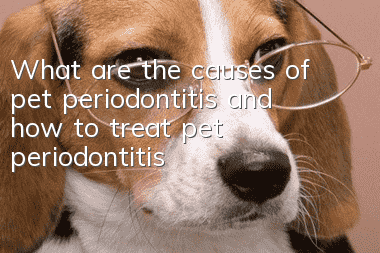What are the causes of pet periodontitis and how to treat pet periodontitis?

Teeth are not only important for humans but also for any animal. In addition to parents, partners, and children, the most common family members we come into contact with in life are cats and dogs. As for teeth, the most common disease is dental disease. They suffer from peritonitis, but it is difficult for us to detect it, especially the early symptoms that make us think that maybe it just ate some smelly food and that's it.
Periodontitis/Alveolar Pyorrhea:
Food and bacteria adhere to the gum line, forming dental plaque, which is then combined with saliva and minerals to transform into dental calculus, the most common form of dog disease. Eventually, it causes gum irritation and acute/chronic inflammation. If it is not taken seriously for a long time, the calculus will increase and increase the gap between the teeth and gums, promote the growth of bacteria, and turn into periodontitis. This disease affects cats and dogs of all ages, but is especially common in the elderly (after three years of age, almost everyone has this disease).
· The first stage: gingivitis
Mild redness can be seen near the gums, accompanied by bad breath
· The second stage: advanced gingivitis
The gums begin to swell, dental calculus exists above and below the gum line, and periodontal pockets (gaps) have formed between the gums and teeth. If it exceeds 3 mm, it indicates abnormal gums
· The third stage: periodontitis
In the advanced stage of gum contact, the periodontal pockets between the teeth and gums increase (may reach 5 mm), the accumulation connects multiple teeth together, and the teeth are slightly shaken
· The fourth stage: advanced periodontitis
About 50% of the bone is lost, a large amount of bacteria accumulates, the gums begin to recede, the teeth become loose, and the gums are squeezed to release purulent secretions/blood
Note: The relevant pictures are not shown because they may cause discomfort.
In addition to the symptoms presented in the above four stages, if parents find symptoms such as bad breath, involuntary drooling, pain, and gradual weight loss during their daily interactions with the dog, they can basically be diagnosed with periodontitis. If parents are unable to determine which stage the dog is in, they can ask the doctor to use a periodontal probe (inserted between the gum line and the pressure difference to measure the presence and depth of the pocket)/diagnose with X-rays (X-ray imaging can clearly show the teeth Density relationship with gums and bone loss).
NOTE: Severe gum disease can damage the bones between the nose and mouth, causing sneezing or runny nose; dogs are at higher risk for heart, kidney, and liver disease; and even mild stress can fracture their jaws.
Causes of periodontitis
1. Pathological
· Chronic renal dysfunction
· Uremia
· Hypothyroidism/hyperthyroidism
·Chronic nephritis
· Diabetes
· Gastric ulcer
2. Bacterial/fungal
· Candida albicans
· Blastomyces dermatitidis
· Histoplasma capsulatum
· Oral microorganisms (Clostridium, Spirochaete)
· Whole Leptospira
· Hemorrhagic jaundice Leptospira
3. Other factors
· Material flow caused by damaged gingival tissue/improper tooth alignment
· Low calcium diet/bacteria in the mouth invade the gums and destroy the dental membrane during the disease process
· Malocclusion of teeth
· Chewing habits
What methods can be used for treatment?
· Clean plaque and calculus in periodontal pockets (need to be removed under anesthesia)
· Polish all tooth surfaces to prevent plaque and stones from accumulating and bonding
·Below the gum line, scrape away all the tartar
· Extract loose teeth without damaging the soft tissue and tooth enamel layer
· Rinse the gums with saline and apply iodine tincture/0.2% zinc oxide solution
· Take metronidazole and co-trimoxazole orally at the same time
· If the gums are enlarged, electric cautery can be used to remove excess tissue
Note: After surgery, antibiotics, B complex vitamins, analgesics, etc. will be used throughout the body; liquid food/easy-to-digest food will be provided within a few days until the gums heal.
How parents can avoid periodontitis:
· Regular (every 3-6 months) oral examination (X-ray/periodontal probe)
· Provide teething toys/food for dogs to scrub their teeth while chewing (such as rubber balls, food leakage balls, etc.)
· Daily cleaning and brushing with dog-specific toothpaste to help reduce plaque
· Chlorhexidine rinse can be used to clean teeth
Pulp lesions (can be mixed with periodontitis/precipitated in periodontitis lesions), periapical (abscesses around teeth, tooth fractures) and fractured mandible bones (secondary to periodontal disease) can also occur with periodontal disease. Symptoms similar to inflammation.
Recommended Good Things
Aineng Pet Odor Eliminating Disinfectant can effectively remove body odor/feces odor and other odor molecules! Effective in treating skin diseases caused by fungi/bacteria! Can kill parvovirus/canine distemper virus/coronavirusetc!
It is edible grade for pets, does not contain fragrances, does not contain chemicals, can be sprayed directly, and is harmless to human pets!
Consultation: 13028809308 (WeChat synchronization)
Scan the QR code on WeChat to enter the purchase
- How to give a dog a massage
- Why can’t dogs eat chicken bones?
- How often should puppies be fed?
- How to train a dog to walk around outside? Dog training!
- What vaccinations do Alaskan Malamutes get?
- How to perform daily fur care for long-haired dogs
- What causes bad breath in dogs
- Dog leg dislocation symptoms and care and treatment methods
- Alzheimer's disease symptoms and prevention methods in dogs
- Can dogs be checked in? How to transport a dog?



